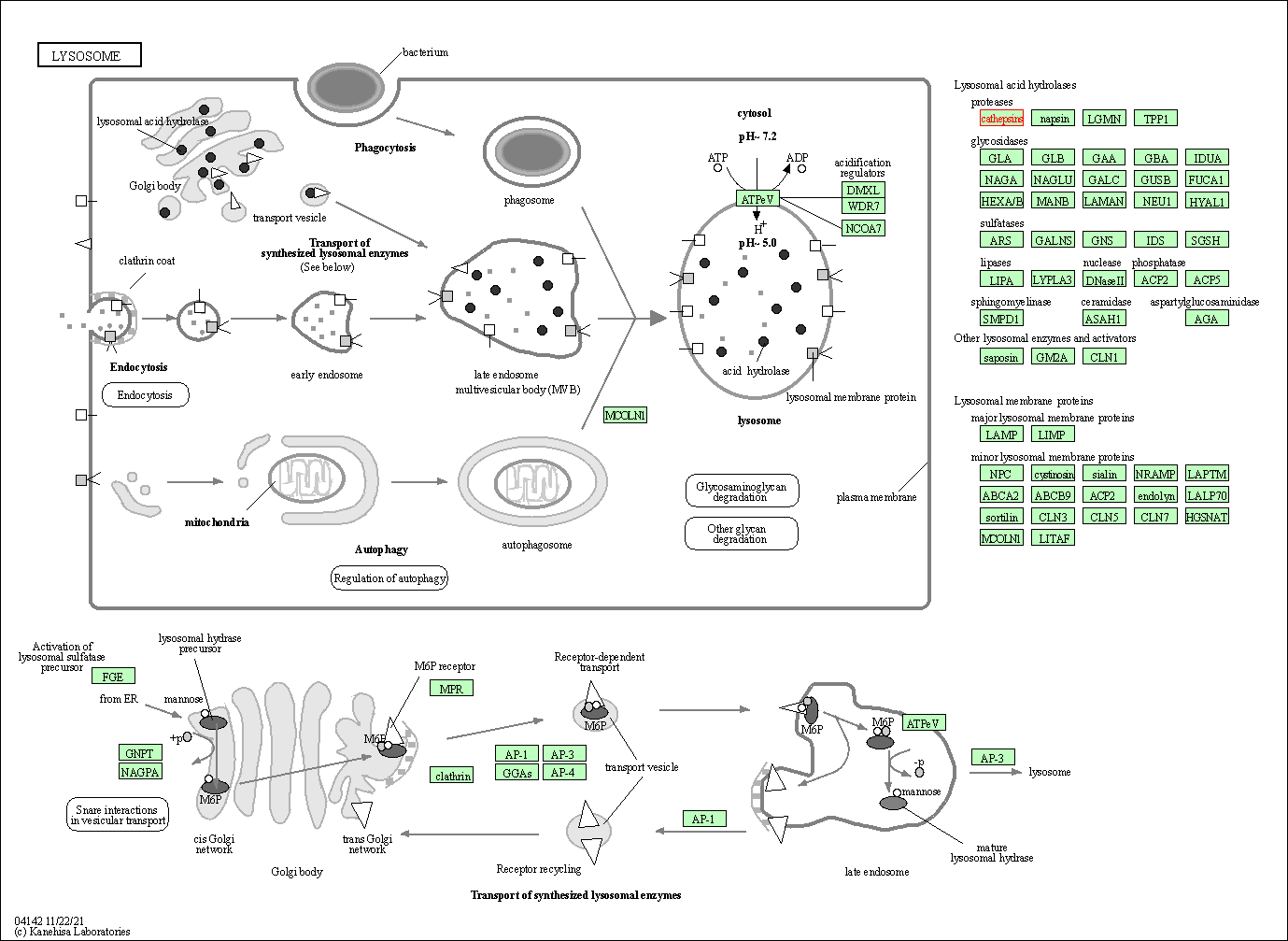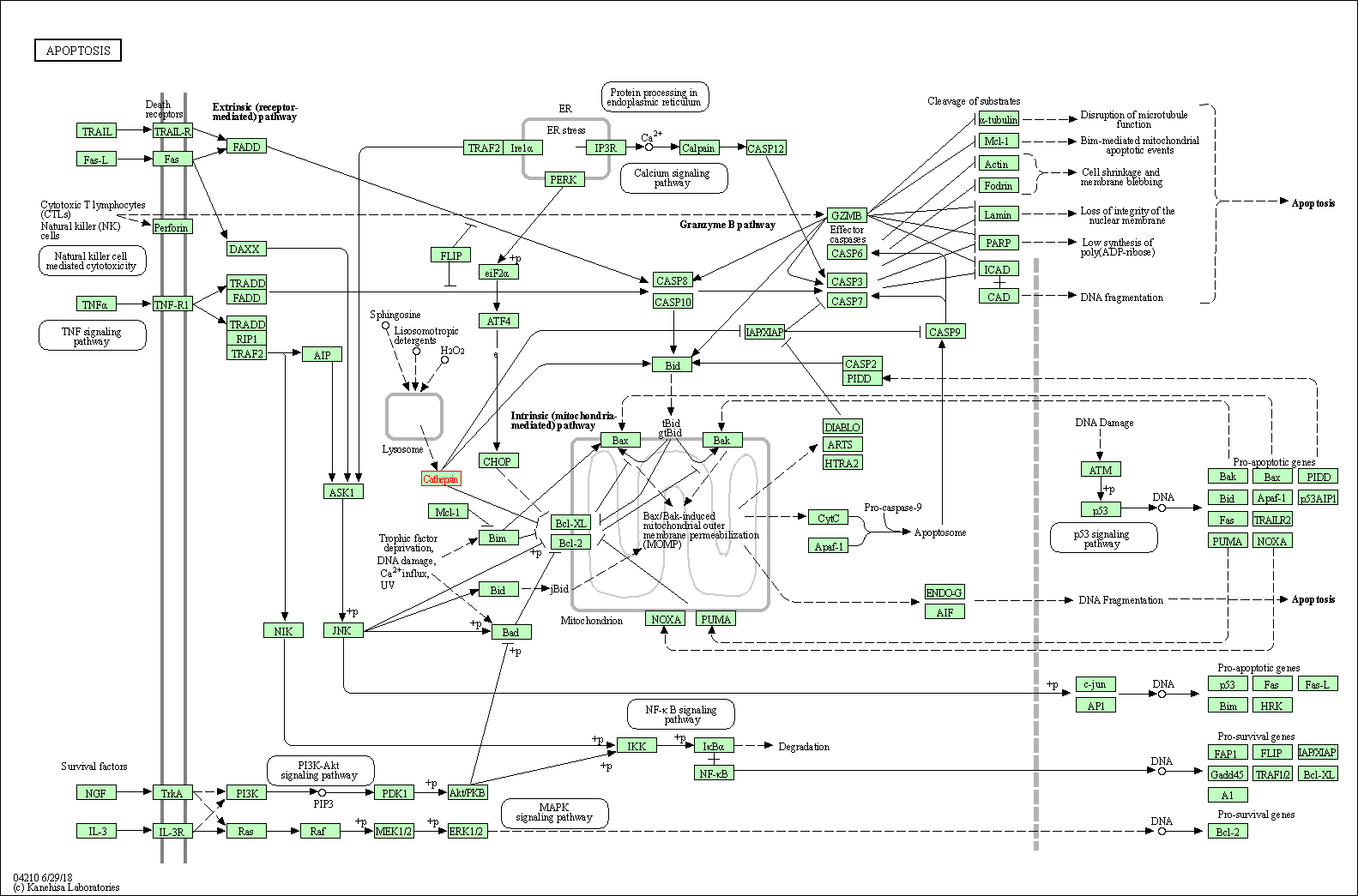Target Information
| Target General Information | Top | |||||
|---|---|---|---|---|---|---|
| Target ID |
T77236
(Former ID: TTDR01032)
|
|||||
| Target Name |
Cathepsin F (CTSF)
|
|||||
| Synonyms |
CATSF
Click to Show/Hide
|
|||||
| Gene Name |
CTSF
|
|||||
| Target Type |
Patented-recorded target
|
[1] | ||||
| Disease | [+] 7 Target-related Diseases | + | ||||
| 1 | Bone cancer [ICD-11: 2B5Z] | |||||
| 2 | Chronic obstructive pulmonary disease [ICD-11: CA22] | |||||
| 3 | Chronic pain [ICD-11: MG30] | |||||
| 4 | Digestive system disease [ICD-11: DE2Z] | |||||
| 5 | Hepatic fibrosis/cirrhosis [ICD-11: DB93] | |||||
| 6 | Multiple sclerosis [ICD-11: 8A40] | |||||
| 7 | Psoriasis [ICD-11: EA90] | |||||
| Function |
Has also been implicated in tumor invasion and metastasis. Thiol protease which is believed to participate in intracellular degradation and turnover of proteins.
Click to Show/Hide
|
|||||
| BioChemical Class |
Peptidase
|
|||||
| UniProt ID | ||||||
| EC Number |
EC 3.4.22.41
|
|||||
| Sequence |
MAPWLQLLSLLGLLPGAVAAPAQPRAASFQAWGPPSPELLAPTRFALEMFNRGRAAGTRA
VLGLVRGRVRRAGQGSLYSLEATLEEPPCNDPMVCRLPVSKKTLLCSFQVLDELGRHVLL RKDCGPVDTKVPGAGEPKSAFTQGSAMISSLSQNHPDNRNETFSSVISLLNEDPLSQDLP VKMASIFKNFVITYNRTYESKEEARWRLSVFVNNMVRAQKIQALDRGTAQYGVTKFSDLT EEEFRTIYLNTLLRKEPGNKMKQAKSVGDLAPPEWDWRSKGAVTKVKDQGMCGSCWAFSV TGNVEGQWFLNQGTLLSLSEQELLDCDKMDKACMGGLPSNAYSAIKNLGGLETEDDYSYQ GHMQSCNFSAEKAKVYINDSVELSQNEQKLAAWLAKRGPISVAINAFGMQFYRHGISRPL RPLCSPWLIDHAVLLVGYGNRSDVPFWAIKNSWGTDWGEKGYYYLHRGSGACGVNTMASS AVVD Click to Show/Hide
|
|||||
| 3D Structure | Click to Show 3D Structure of This Target | AlphaFold | ||||
| Drugs and Modes of Action | Top | |||||
|---|---|---|---|---|---|---|
| Patented Agent(s) | [+] 2 Patented Agents | + | ||||
| 1 | PMID27998201-Compound-12 | Drug Info | Patented | Cancer related pain | [1] | |
| 2 | PMID27998201-Compound-5 | Drug Info | Patented | Cirrhosis | [1] | |
| Mode of Action | [+] 1 Modes of Action | + | ||||
| Inhibitor | [+] 7 Inhibitor drugs | + | ||||
| 1 | PMID27998201-Compound-12 | Drug Info | [1] | |||
| 2 | PMID27998201-Compound-5 | Drug Info | [1] | |||
| 3 | Benzoyl-Arginine-Alanine-Methyl Ketone | Drug Info | [2] | |||
| 4 | HOMOPHENYLALANINYLMETHANE | Drug Info | [3] | |||
| 5 | PMID22686657C(R)-26 | Drug Info | [4] | |||
| 6 | WRR-112 | Drug Info | [2] | |||
| 7 | WRR-99 | Drug Info | [2] | |||
| Cell-based Target Expression Variations | Top | |||||
|---|---|---|---|---|---|---|
| Cell-based Target Expression Variations | ||||||
| Drug Binding Sites of Target | Top | |||||
|---|---|---|---|---|---|---|
| Ligand Name: N-[(2S)-1-[[(Z,3S)-1-(benzenesulfonyl)hex-1-en-3-yl]amino]-1-oxo-3-phenylpropan-2-yl]-4-morpholin-4-ylpiperidine-1-carboxamide | Ligand Info | |||||
| Structure Description | Crystal structure of human cathepsin F | PDB:1M6D | ||||
| Method | X-ray diffraction | Resolution | 1.70 Å | Mutation | Yes | [5] |
| PDB Sequence |
APPEWDWRSK
10 GAVTKVKDQG20 MCGSCWAFSV30 TGNVEGQWFL40 NQGTLLSLSE50 QELLDCDKMD 60 KACMGGLPSN70 AYSAIKNLGG79 LETEDDYSYQ89 GHMQSCQFSA99 EKAKVYIQDS 110 VELSQNEQKL120 AAWLAKRGPI130 SVAINAFGMQ142 FYRHGISRPL154A RPLCSPWLID 158 HAVLLVGYGQ167A RSDVPFWAIK174 NSWGTDWGEK184 GYYYLHRGSG198 ACGVNTMASS 208 AVVD
|
|||||
|
|
GLN19
3.004
CYS22
4.066
GLY23
3.420
SER24
4.582
CYS25
1.824
TRP26
3.209
CYS63
4.157
MET64
3.741
GLY65
3.099
GLY66
2.893
LEU67
3.537
|
|||||
| Click to View More Binding Site Information of This Target with Different Ligands | ||||||
| Different Human System Profiles of Target | Top |
|---|---|
|
Human Similarity Proteins
of target is determined by comparing the sequence similarity of all human proteins with the target based on BLAST. The similarity proteins for a target are defined as the proteins with E-value < 0.005 and outside the protein families of the target.
A target that has fewer human similarity proteins outside its family is commonly regarded to possess a greater capacity to avoid undesired interactions and thus increase the possibility of finding successful drugs
(Brief Bioinform, 21: 649-662, 2020).
Human Tissue Distribution
of target is determined from a proteomics study that quantified more than 12,000 genes across 32 normal human tissues. Tissue Specificity (TS) score was used to define the enrichment of target across tissues.
The distribution of targets among different tissues or organs need to be taken into consideration when assessing the target druggability, as it is generally accepted that the wider the target distribution, the greater the concern over potential adverse effects
(Nat Rev Drug Discov, 20: 64-81, 2021).
Human Pathway Affiliation
of target is determined by the life-essential pathways provided on KEGG database. The target-affiliated pathways were defined based on the following two criteria (a) the pathways of the studied target should be life-essential for both healthy individuals and patients, and (b) the studied target should occupy an upstream position in the pathways and therefore had the ability to regulate biological function.
Targets involved in a fewer pathways have greater likelihood to be successfully developed, while those associated with more human pathways increase the chance of undesirable interferences with other human processes
(Pharmacol Rev, 58: 259-279, 2006).
Human Similarity Proteins
Human Tissue Distribution
Human Pathway Affiliation
|
|
|
There is no similarity protein (E value < 0.005) for this target
|
|
Note:
If a protein has TS (tissue specficity) scores at least in one tissue >= 2.5, this protein is called tissue-enriched (including tissue-enriched-but-not-specific and tissue-specific). In the plots, the vertical lines are at thresholds 2.5 and 4.
|
| KEGG Pathway | Pathway ID | Affiliated Target | Pathway Map |
|---|---|---|---|
| Lysosome | hsa04142 | Affiliated Target |

|
| Class: Cellular Processes => Transport and catabolism | Pathway Hierarchy | ||
| Apoptosis | hsa04210 | Affiliated Target |

|
| Class: Cellular Processes => Cell growth and death | Pathway Hierarchy | ||
| Chemical Structure based Activity Landscape of Target | Top |
|---|---|
| Drug Property Profile of Target | Top | |
|---|---|---|
| (1) Molecular Weight (mw) based Drug Clustering | (2) Octanol/Water Partition Coefficient (xlogp) based Drug Clustering | |
|
|
||
| (3) Hydrogen Bond Donor Count (hbonddonor) based Drug Clustering | (4) Hydrogen Bond Acceptor Count (hbondacc) based Drug Clustering | |
|
|
||
| (5) Rotatable Bond Count (rotbonds) based Drug Clustering | (6) Topological Polar Surface Area (polararea) based Drug Clustering | |
|
|
||
| "RO5" indicates the cutoff set by lipinski's rule of five; "D123AB" colored in GREEN denotes the no violation of any cutoff in lipinski's rule of five; "D123AB" colored in PURPLE refers to the violation of only one cutoff in lipinski's rule of five; "D123AB" colored in BLACK represents the violation of more than one cutoffs in lipinski's rule of five | ||
| Target Poor or Non Binders | Top | |||||
|---|---|---|---|---|---|---|
| Target Poor or Non Binders | ||||||
| Target Affiliated Biological Pathways | Top | |||||
|---|---|---|---|---|---|---|
| KEGG Pathway | [+] 1 KEGG Pathways | + | ||||
| 1 | Lysosome | |||||
| NetPath Pathway | [+] 1 NetPath Pathways | + | ||||
| 1 | IL2 Signaling Pathway | |||||
| Reactome | [+] 1 Reactome Pathways | + | ||||
| 1 | MHC class II antigen presentation | |||||
| Target-Related Models and Studies | Top | |||||
|---|---|---|---|---|---|---|
| Target Validation | ||||||
| References | Top | |||||
|---|---|---|---|---|---|---|
| REF 1 | Cathepsin B and L inhibitors: a patent review (2010 - present).Expert Opin Ther Pat. 2017 Jun;27(6):643-656. | |||||
| REF 2 | How many drug targets are there Nat Rev Drug Discov. 2006 Dec;5(12):993-6. | |||||
| REF 3 | The Protein Data Bank. Nucleic Acids Res. 2000 Jan 1;28(1):235-42. | |||||
| REF 4 | Selective nitrile inhibitors to modulate the proteolytic synergism of cathepsins S and F. J Med Chem. 2012 Jun 28;55(12):5982-6. | |||||
| REF 5 | The crystal structure of human cathepsin F and its implications for the development of novel immunomodulators. J Mol Biol. 2002 Sep 20;322(3):559-68. | |||||
If You Find Any Error in Data or Bug in Web Service, Please Kindly Report It to Dr. Zhou and Dr. Zhang.

